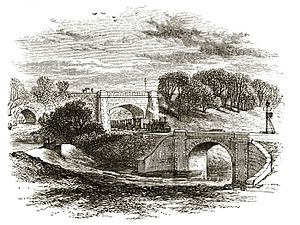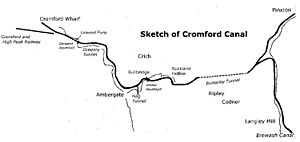Bullbridge Aqueduct facts for kids
Quick facts for kids Bullbridge Aqueduct |
|
|---|---|

Bullbridge Aqueduct from the east
|
|
| Coordinates | 53°03′49″N 1°28′18″W / 53.0636°N 1.4716°W |
| OS grid reference | |
| Carries | Cromford Canal |
| Crosses | Amber Valley |
| Locale | Bullbridge |
| Characteristics | |
| Total length | 150 feet (46 m) |
| Width | 9 feet (2.7 m) |
| Height | 6 feet (1.8 m) |
| Towpaths | No |
| History | |
| Opened | 1840 |
| Closed | 1968 |

Sketch of the canal
|
|
The Bull Bridge Aqueduct was a special bridge that carried the Cromford Canal over the Amber Valley in Derbyshire, England. It was built in 1794 near Bullbridge, east of Ambergate. This important structure allowed canal boats to cross the valley and the main road without problems.
What Was the Bullbridge Aqueduct?
Even though it was called an aqueduct, it was more like a huge earth bank with stone walls. This bank was about 30 feet (9 meters) high in some places. It had three large arches built into it.
One arch was for the River Amber to flow through. Another arch was a pathway for local houses, which later became the small village of Bullbridge. The third arch allowed the main road to pass underneath. This original road crossing was known as the Bull Bridge.
A Clever Railway Crossing
In 1840, a famous engineer named George Stephenson designed the North Midland Railway. This new railway needed to cross the canal right at the aqueduct. The railway lines were placed between the river and the road.
To avoid stopping canal traffic, Stephenson's team came up with a smart solution. They built a large iron tank, 150 feet (45 meters) long, 6 feet (1.8 meters) deep, and 9 feet (2.7 meters) wide. This tank was made in pieces at the Butterley Company's ironworks.
The pieces were put together on site. Then, the whole tank was floated into place on the canal. It was carefully sunk and set into position during the night. This amazing feat meant that canal boats could keep moving without any delays!
A writer from that time described the scene as "river, road, railway and canal were thus piled up, four stories high." This shows how many different ways of travel were stacked on top of each other in one spot.
In 1860, the railway bridge had a problem when a goods train passed over it. Luckily, no one was hurt in the incident.
The End of an Era
In the early 1900s, the Cromford Canal was used less and less. The aqueduct, where it crossed the main highway, was only wide enough for one car at a time. Traffic lights had to control the flow of cars.
By 1968, the road became a busy route connecting to the newly improved A38 and the M1. Because it was too narrow for modern traffic, the Bullbridge Aqueduct was taken down.

